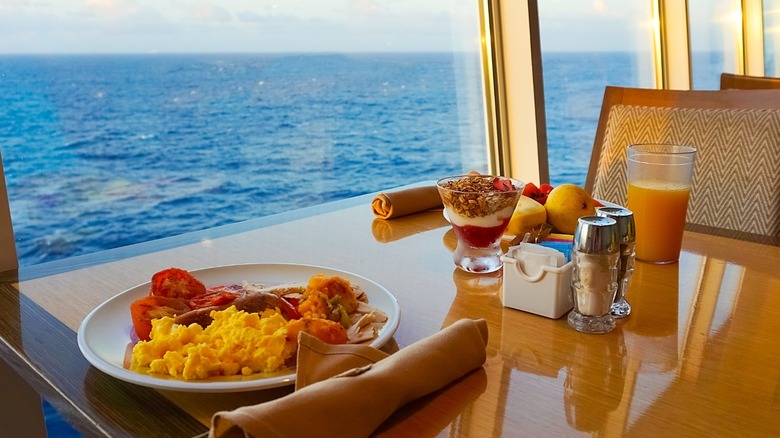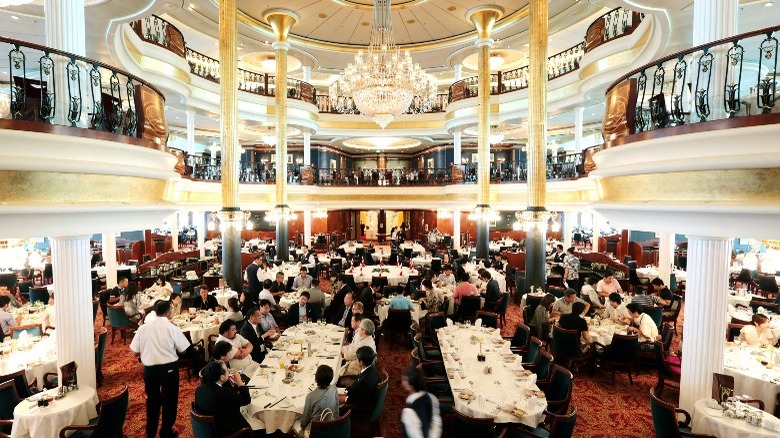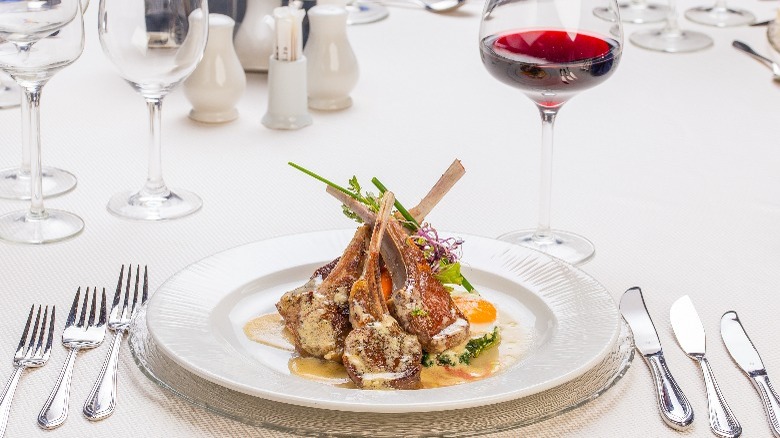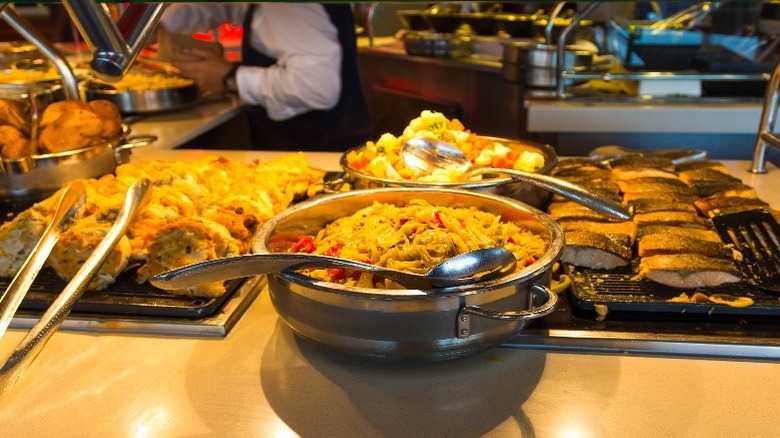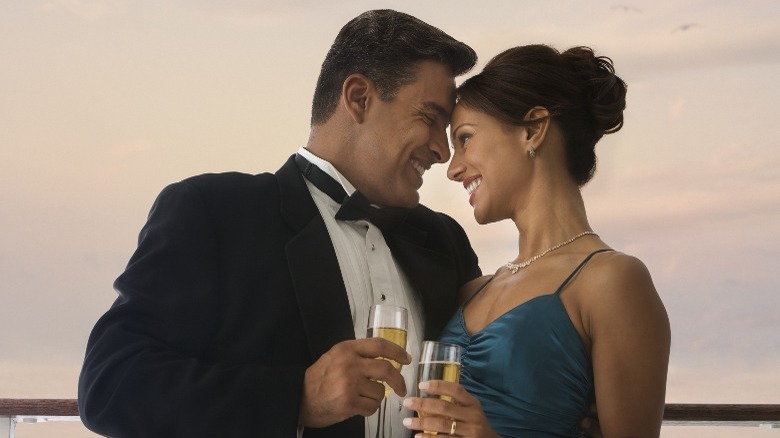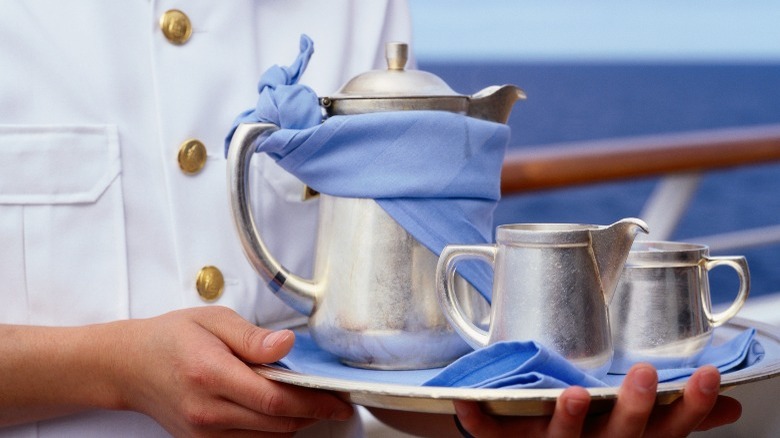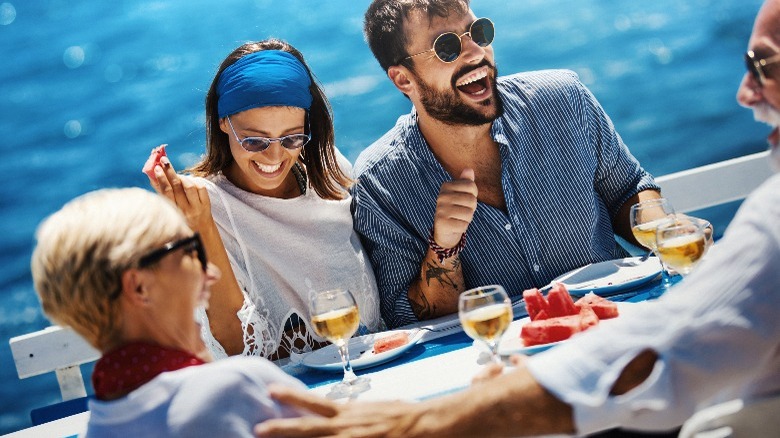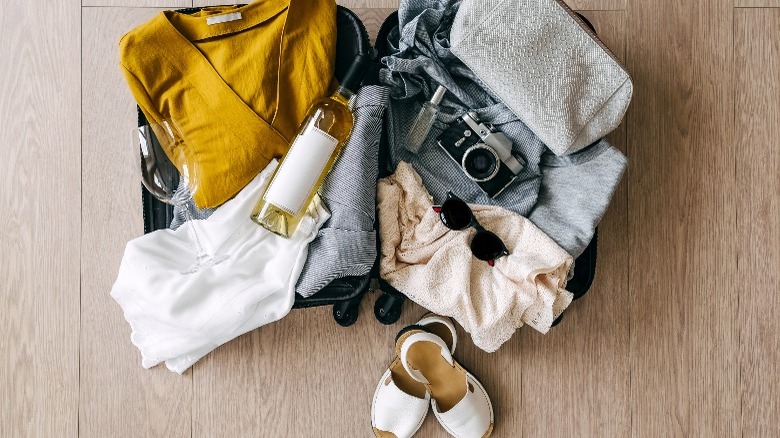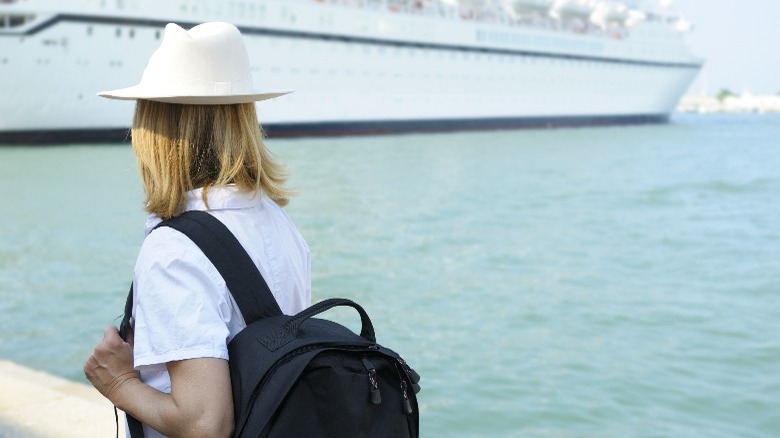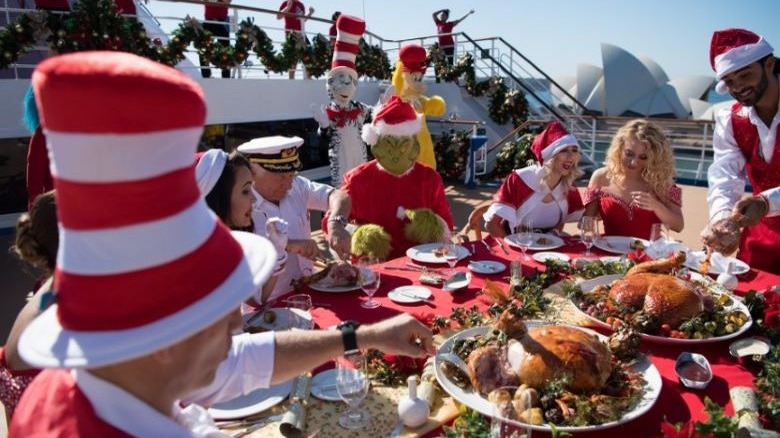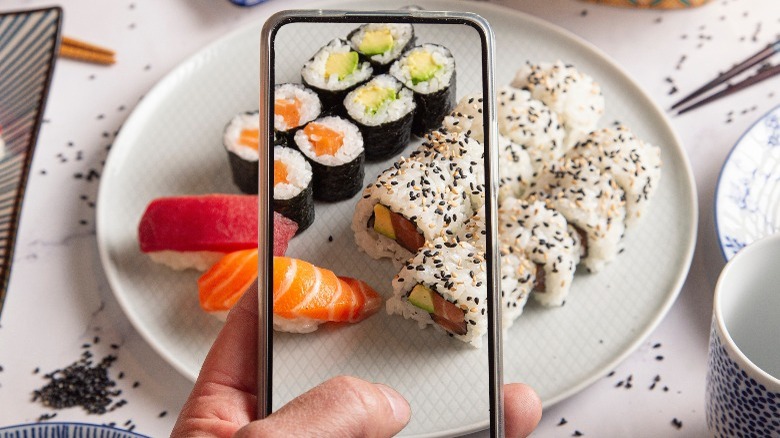The Ultimate Guide To Dining On A Cruise
Back in the days when ships like Titanic cruised the oceans, dinner for first-class passengers was an involved affair with guests donning their finest clothing and lingering for hours over lengthy courses. And while this kind of dining experience is still offered, it is far from the only one. There's always food somewhere on the ship, and while that is pretty incredible, it can also seem overwhelming. This ultimate guide is the perfect resource for navigating the options and knowing what to expect.
Cruise lines approach these setups in various ways, with different options and events on every ship. Two well-known ones are Disney Cruises Character Breakfasts and Viking Cruises' lovely al fresco dining. That's in addition to main dining halls, buffets, specialty restaurants, and food-themed excursions — we're just getting started here.
Many experienced cruisers plan these trips to revolve around eating, but these seafaring vacations have many other activities onboard that shouldn't be missed. So while it's fine to prioritize some foodie experiences, understanding the often complicated options can save you time and money. After you read this guide, you'll be prepared and even more eager to enjoy your cruise.
Read over all the options when booking
Before booking a cruise, research the dining options to get an overall picture of what the ship offers. Each liner should have a link to all the different eateries on their website. The food and certain non-alcoholic drinks are included in the price but there are usually dining options with added fees. As for beer, wine, and cocktails, these are also served everywhere on the ship. You can pay-as-you-go but if you plan to have a lot, it makes sense to purchase a drink package. There might be options for basic and top-shelf, which can save money in the long run.
Certain cruise ship restaurants require reservations and the time slots can get taken quickly. This can be very disappointing if you and your companions show up at the ship's most popular restaurant, only to find that no tables are available. The only other option might be to head back to the buffet, where you had lunch earlier in the day. Bummer.
That problem can be avoided by choosing a dining plan and making reservations when booking the cruise — if you decide to change your mind, you can always eat elsewhere. Also, decide about purchasing a drinks package in advance so you won't have to worry about that while onboard.
Understand the dining times
When a ship has 24/7 food you won't be as restricted and you might decide to grab something at one of the smaller cafes or buffets late at night, just because you can. However, the big cruise lines generally have set mealtime options for their main dining halls. There are usually different seating options and reservations may be necessary. Otherwise, you can show up during the allotted meal time. Expect breakfast to be served from 7 a.m. to 9 a.m., and lunch from about noon until 2 p.m.
Dinnertime is generally from either 5:30 p.m. to 6:30 p.m., or from 8 p.m. onward, depending on the slot you're assigned. These are rough estimates since open dining can be from 5:30 until 9:30 at night. And if you book excursions and aren't onboard at mealtimes, you'll eat elsewhere. These off-ship adventures might include food in the price; otherwise, you'll be on your own.
Main dining room
The main dining area may have a buffet or offer sit-down service, and this is typically the largest place to enjoy meals. The wait staff set up the tables and may take orders and bring food, or just be there to fill coffee cups and stay on top of cleanup. This is often the place where cruisers eat most of their meals. One section might be separated for flex-time diners and another might be designated for those with reservations. And, on the largest ships, there might be more than one main dining room.
Even when the main dining room doesn't have a buffet, feel free to order more than one entrée. This is not looked down upon, though it's also not a free pass to waste food. You can linger awhile at the table but if you see that people are waiting to get in, it's polite to finish up and move on to the next activity.
Specialty restaurants
Cruise ship specialty restaurants are separate from the main dining hall and while some are included in the price, others cost extra: Celebrity Cruises' Edge ship has a steakhouse, a French bistro, and a casual seafood spot on the top deck and the price paid might be worth the experience.
These restaurants and similar ones offer sit-down service and food options not found in the main dining halls. There will always be at least one elegant choice but there might be modestly priced ones, too. Eating at one each day could end up being pretty expensive and some people reserve them for special occasions. Still, many cruise line specialty restaurants rival the top eateries around the world and can be a highlight of your cruise. If you decide to go for it, expect to spend considerably more time at the table than you would in the main dining hall.
Buffets
A cruise ship buffet is a beautiful thing for so many reasons. Besides eating as much as you like, you can sample unusual foods and generally be done in less than an hour. There will be multiple themed stations to browse, with everything from made-to-order omelets and salad bars to Mexican food. The chefs behind the counters might serve the food, and many will even sing for you. There are also stations with things like fruit or plated desserts that cruisers can take for themselves.
Since people usually show up at buffets according to their own schedules, how busy they will be is hard to predict — there could be no waiting time or long lines at some of the stations. However, these usually move fast, unless it's made-to-order food. Showing up early can help, but some food might not be ready. Arriving near closing time is never a good idea, since there might not be as much of a selection left.
Room service
Depending on the size of the cabin, room service can be a great option. Some have private balconies with tables and chairs or large indoor eating areas, but others aren't as comfortable in this respect. Room service can be great if you're not feeling well or don't feel like schlepping to the dining room: The thought of opening up the cabin door to see breakfast waiting for you on a tray is quite appealing. And after you're finished eating, everything will be taken out of the room the next time it's cleaned.
Many cruise lines offer complimentary room service breakfasts but that might only include basics like coffee, pastries, and a few other light items. That can work well when you have an early excursion departure time. Not all ships do this and most charge convenience fees for delivery. Norwegian Bliss offers 24/7 room service with a $9.95 per-order charge, with a few exceptions.
What to wear
One of the best things about cruising is being able to wear what you want most of the time. Cruise ship dress codes are more casual than they were 100 years ago but formal wear is still common — and also expected in some restaurants. Breakfast and lunch are often come-as-you-are, especially at outdoor buffets set up by swimming pools. Many people show up in swimsuits, but you might be more comfortable wearing a coverup and sandals.
Dinner can be different unless it's enjoyed in a very casual setting. People will arrive in bathing suits for this meal in the main dining rooms but it can feel better to get changed. You'll want to dress up more for specialty restaurant meals and, if there is a formal night, black tie might be specified.
Certain cruise lines are more casual than others. Carnival is possibly the most laid-back, while Crystal Cruises guests are donned in stylish resort wear and switch to more elegant clothes in the evenings. Ones like Disney, Holland America, and Norwegian are in the middle. Pack a little bit of everything, but make sure that everything is comfortable — you'll be doing a lot of walking to get to the restaurants, especially on larger ships.
Dealing with food allergies
Dealing with food allergies on a cruise does not have to be a major challenge when the proper precautions are taken. The culinary staff handle these matters frequently and should be eager to help. The allergies can be explained to the cruise line representative or your travel agent when booking, but it's important to follow up when you check in. With severe allergies, alert them as far ahead of time as possible — some cruise lines require 90 days advance notice. Don't be shy about asking to speak with the dining room manager or other staff members before eating, either.
The chances of having an allergic reaction are higher with buffets since there's more variety and much of the food is made earlier. Be careful with excursions too, since there will be local food. The last few tips for cruising with food allergies are just as important: Ask about onboard medical care, purchase travel insurance, and bring an EpiPen.
Get to know the dining staff
You might think that cruise ship staff members have it easy, but, while it can be rewarding, they can work several months straight with few or no days off. The hours are long, and they often live in small cabins. This doesn't mean that they're all unhappy — it's common to see big smiles and, as mentioned earlier, singing.
After a few days onboard, you'll start recognizing particular dining staff members and might even have a few favorites. They come from across the globe and the friendliest ones won't hesitate to exchange a few words with the guests. Return the favor and be pleasant to all the dining room employees because that will make their jobs easier. As for tipping, most cruise lines include gratuities with the onboard bills. Those get split up by servers and other ship staff members. Some luxury lines have no-tipping policies.
About assigned vs. open seating
There are pros and cons to assigned and open seating in main dining rooms and you can choose to do a bit of both when cruising. Assigned times require your presence when specified and that guarantees a table, but you may still have to wait if the restaurant is crowded. Assigned is also best when you have an activity dinner — experienced cruisers know to pick the 6 p.m. seating so they can be in the theater seats by 8 p.m.
Open seating is great when you don't want to be restricted to set times. Want another hour in the pool? If the dining room is still open at 8 p.m., you can mosey over then, but you may have to contend with longer lines and slower service. And if you're with a large party, it might need to be split up between tables. But with assigned and open seating times, there's the possibility that you'll be seated with strangers. This might not be ideal for everyone, but it can be a nice perk for singles who cruise alone.
Dining with children
Almost every cruise line allows children on board and some are more geared for family fun. The kids' menus are usually full of things like chicken nuggets, grilled cheese, ice cream sundaes, and other things children love. And, of course, they can have a ball at the buffet, but parents and caregivers should accompany younger ones when they're picking out the food and drinks. Disney Cruise Line and some others will even puree food for guests, but be sure to check about that before booking.
Older kids might be comfortable at formal specialty restaurants as long as they are happy with the food and setting. But don't force a young child to go somewhere they'll be dissatisfied because you won't be able to enjoy the meal. Cruise lines often provide babysitting services and have kids' clubs that serve food; these give parents a well-deserved break. The lines with the best kids' dining options include Carnival, Celebrity, Princess, Royal Caribbean, and, of course, Disney.
Bringing food and drinks onto the ship
Guests are permitted to bring certain amounts of pre-packaged, non-perishable food and drinks on cruise ships but each line has its own rules. Norwegian prohibits all alcoholic and non-alcoholic drinks and unsealed food, and Celebrity doesn't permit alcoholic beverages and food that needs refrigeration. Royal Caribbean has a different policy that allows guests to bring a single, 750 ml bottle of champagne or wine and up to 12 (17-ounce maximum size) cans or bottles of non-alcoholic beverages. If you bring more than that, they'll hold it in storage until the ship returns home.
The savings will be negligible if you planned to spend less on a cruise by bringing your own food and drinks. It can be nice to bring a bottle of wine for the sailing and juice boxes and snacks for the kids to keep in the room, but overdoing it isn't worthwhile. And don't think that you can get away with sneaking stuff by — things get through sometimes, but carry-on luggage gets x-rayed at the Port Authority and checked bags are scanned.
Taking food off the ship
If you're wondering if people disembark from cruises with pilfered food stashed in their bags, the answer is definitely yes. It's hard to resist doing so with such an abundance of offerings and many get away with it. But, while it might feel like getting something for free, it drives cruise costs up for everyone. Feel free to take the packaged cookie and candy samples from the spa but it's unwise to fill up Ziploc bags with muffins from the breakfast buffet.
As for bringing ship food into ports, countries have different regulations that may apply. Never take fresh fruits, vegetables, or meats in because they could be confiscated and you might be fined. The ships usually have signs advising passengers about this. It's okay to include pre-packaged snacks in your backpack and to bring purchased food and drink back to the ship, subject to the cruise line's regulations.
The importance of pacing yourself
Cruises are often compared to floating smorgasbords and there's nothing wrong with a bit of overindulging. It's pretty much impossible to taste every single food and drink offered onboard, but plenty of people give it their best shot. There's no limit to how much you can eat at most meals, and some of the specialty restaurants even allow guests to order more than one entrée. Therein lies the problems associated with overdoing it.
Without boundaries, guests are more likely to order seconds, thirds, and fourths, and to keep piling up plates at the buffet. And you might feel like all the different restaurants also need to be sampled. However, it's vital to pace eating on cruises because consuming too much makes people feel tired and lazy — sleeping half the day away is a waste of money. Drinking too much alcohol is also ill-advised because it can produce the same results. Excess food and drink also make people feel ill and if that's combined with seasickness... well, it can get messy.
Enjoying food on holiday cruises
Holiday cruises can be a blast, with all of the beautiful decorations, themed events, and extra-special food choices. Many singles, groups, and families opt for these trips because the experience is less stressful than home holiday gatherings and they get to have copious amounts of gourmet food. Carnival Cruise's 2022 Christmas Menu was quite impressive, with apps like ribeye tartare. There were traditional entrées like turkey and stuffing, but also more adventurous ones like guava glazed chicken and stuffed pork belly. The menu also had vegetarian and vegan entrées, plus desserts like hazelnut pate and pecan pie.
Norwegian Cruise Line served eggnog at the pool on their Christmas 2022 cruises and traditional Thanksgiving dinners in its main dining rooms for those November cruises. That's not to say you're obliged to eat traditionally if you go on a cruise during the holidays — guests who aren't interested in that kind of food also have the option of visiting the other restaurants, which will still be open.
Special dining events
Cruisers who book trips might get so caught up with meal plans and reservations that they forget about making reservations for some of the unique experiences that ships offer. For example, Royal Caribbean has a sushi-making class that allows participants to roll up and then eat what they create. Other options might include a barbecue night or a French cooking class. Windstar offers Culinary Shore Excursions that incorporate wine tastings, market tours, and other food-and-drink-related activities.
Yet one of the most sought-after dining experiences is a meal at the captain's table. This is typically reserved for VIP guests but it's possible to be chosen by a staff member. The key is to catch their eye with your style and charisma or to be a frequent cruise line guest that gets noticed. We can't promise that you'll get an invite, but with the right look, attitude, or smile, one never knows.
